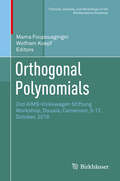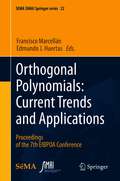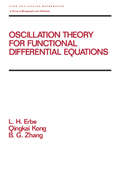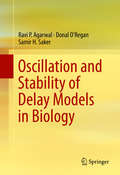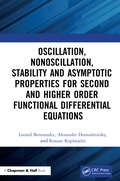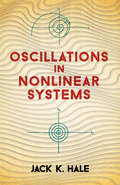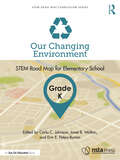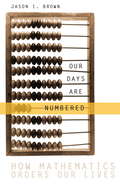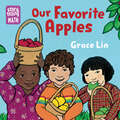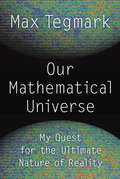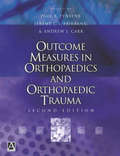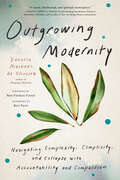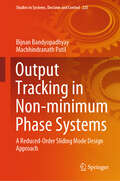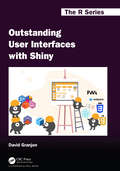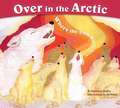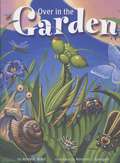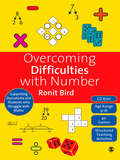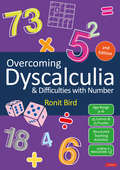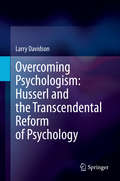- Table View
- List View
Orthogonal Polynomials: 2nd AIMS-Volkswagen Stiftung Workshop, Douala, Cameroon, 5-12 October, 2018 (Tutorials, Schools, and Workshops in the Mathematical Sciences)
by Wolfram Koepf Mama FoupouagnigniThis book presents contributions of international and local experts from the African Institute for Mathematical Sciences (AIMS-Cameroon) and also from other local universities in the domain of orthogonal polynomials and applications. The topics addressed range from univariate to multivariate orthogonal polynomials, from multiple orthogonal polynomials and random matrices to orthogonal polynomials and Painlevé equations.The contributions are based on lectures given at the AIMS-Volkswagen Stiftung Workshop on Introduction of Orthogonal Polynomials and Applications held on October 5–12, 2018 in Douala, Cameroon. This workshop, funded within the framework of the Volkswagen Foundation Initiative "Symposia and Summer Schools", was aimed globally at promoting capacity building in terms of research and training in orthogonal polynomials and applications, discussions and development of new ideas as well as development and enhancement of networking including south-south cooperation.
Orthogonal Polynomials: Proceedings of the 7th EIBPOA Conference (SEMA SIMAI Springer Series #22)
by Francisco Marcellán Edmundo J. HuertasThe present volume contains the Proceedings of the Seventh Iberoamerican Workshop in Orthogonal Polynomials and Applications (EIBPOA, which stands for Encuentros Iberoamericanos de Polinomios Ortogonales y Aplicaciones, in Spanish), held at the Universidad Carlos III de Madrid, Leganés, Spain, from July 3 to July 6, 2018.These meetings were mainly focused to encourage research in the fields of approximation theory, special functions, orthogonal polynomials and their applications among graduate students as well as young researchers from Latin America, Spain and Portugal. The presentation of the state of the art as well as some recent trends constitute the aim of the lectures delivered in the EIBPOA by worldwide recognized researchers in the above fields.In this volume, several topics on the theory of polynomials orthogonal with respect to different inner products are analyzed, both from an introductory point of view for a wide spectrum of readers without an expertise in the area, as well as the emphasis on their applications in topics as integrable systems, random matrices, numerical methods in differential and partial differential equations, coding theory, and signal theory, among others.
Oscillation Theory for Functional Differential Equations (Chapman And Hall/crc Pure And Applied Mathematics Ser. #190)
by Lynn ErbeExamines developments in the oscillatory and nonoscillatory properties of solutions for functional differential equations, presenting basic oscillation theory as well as recent results. The book shows how to extend the techniques for boundary value problems of ordinary differential equations to those of functional differential equations.
Oscillation Theory for Second Order Dynamic Equations (Mathematical Analysis and Applications)
by Ravi P. Agarwal Said R. Grace Donal O'ReganThe qualitative theory of dynamic equations is a rapidly developing area of research. In the last 50 years, many scholars have studied the oscillation theory of ordinary, functional, neutral, partial, and impulsive differential equations. Many books deal with oscillation theory, but in a way that appeals only to researchers already familiar with the subject. In an effort to bring the topic to a new and broader audience, the authors clearly explain oscillation theory for second-order differential equations. They include several examples to illustrate the theory and to inspire new direction. This text is ideal for students and researchers in applied mathematics, engineering science, and numerical analysis.
Oscillation and Stability of Delay Models in Biology
by Ravi P. Agarwal Donal O'Regan Samir H. SakerEnvironmental variation plays an important role in many biological and ecological dynamical systems. This monograph focuses on the study of oscillation and the stability of delay models occurring in biology. The book presents recent research results on the qualitative behavior of mathematical models under different physical and environmental conditions, covering dynamics including the distribution and consumption of food. Researchers in the fields of mathematical modeling, mathematical biology, and population dynamics will be particularly interested in this material.
Oscillation, Nonoscillation, Stability and Asymptotic Properties for Second and Higher Order Functional Differential Equations
by Alexander Domoshnitsky Leonid Berezansky Roman KoplatadzeAsymptotic properties of solutions such as stability/ instability,oscillation/ nonoscillation, existence of solutions with specific asymptotics, maximum principles present a classical part in the theory of higher order functional differential equations. The use of these equations in applications is one of the main reasons for the developments in this field. The control in the mechanical processes leads to mathematical models with second order delay differential equations. Stability and stabilization of second order delay equations are one of the main goals of this book. The book is based on the authors’ results in the last decade. Features: Stability, oscillatory and asymptotic properties of solutions are studied in correlation with each other. The first systematic description of stability methods based on the Bohl-Perron theorem. Simple and explicit exponential stability tests. In this book, various types of functional differential equations are considered: second and higher orders delay differential equations with measurable coefficients and delays, integro-differential equations, neutral equations, and operator equations. Oscillation/nonoscillation, existence of unbounded solutions, instability, special asymptotic behavior, positivity, exponential stability and stabilization of functional differential equations are studied. New methods for the study of exponential stability are proposed. Noted among them inlcude the W-transform (right regularization), a priory estimation of solutions, maximum principles, differential and integral inequalities, matrix inequality method, and reduction to a system of equations. The book can be used by applied mathematicians and as a basis for a course on stability of functional differential equations for graduate students.
Oscillations in Nonlinear Systems (Dover Books on Mathematics)
by Jack K. HaleBy focusing on ordinary differential equations that contain a small parameter, this concise graduate-level introduction to the theory of nonlinear oscillations provides a unified approach to obtaining periodic solutions to nonautonomous and autonomous differential equations. It also indicates key relationships with other related procedures and probes the consequences of the methods of averaging and integral manifolds.Part I of the text features introductory material, including discussions of matrices, linear systems of differential equations, and stability of solutions of nonlinear systems. Part II offers extensive treatment of periodic solutions, including the general theory for periodic solutions based on the work of Cesari-Halel-Gambill, with specific examples and applications of the theory. Part III covers various aspects of almost periodic solutions, including methods of averaging and the existence of integral manifolds. An indispensable resource for engineers and mathematicians with knowledge of elementary differential equations and matrices, this text is illuminated by numerous clear examples.
Our Changing Environment, Grade K: STEM Road Map for Elementary School (STEM Road Map Curriculum Series)
by Carla C. Johnson Erin E. Peters-Burton Janet B. WaltonWhat if you could challenge your kindergartners to come up with a way to reduce human impact on the environment? With this volume in the STEM Road Map Curriculum Series, you can! Our Changing Environment outlines a journey that will steer your students toward authentic problem solving while grounding them in integrated STEM disciplines. Like the other volumes in the series, this book is designed to meet the growing need to infuse real-world learning into K–12 classrooms. This interdisciplinary, three-lesson module uses project- and problem-based learning to help students investigate the environment around them, with a focus on ways that humans can impact the environment. Working in teams, students will investigate various types of human impact on the environment (including pollution, littering, and habitat destruction), will participate in a classroom recycling program, and will explore the engineering design process as they devise ways to repurpose waste materials. To support this goal, students will do the following: Identify human impacts on the environment. Identify technological advances and tools that scientists use to learn about the changing environment, and use technology to gather data. Explain, discuss, and express concepts about the environment through development and design of a publication to report their scientific findings about the environment around the school. Chart and understand local weather patterns, and make connections between weather conditions and their observations of the environment. Identify and demonstrate recycling practices, including sorting materials and tracking amounts of materials recycled, and participate in a class recycling program. The STEM Road Map Curriculum Series is anchored in the Next Generation Science Standards, the Common Core State Standards, and the Framework for 21st Century Learning. In-depth and flexible, Our Changing Environment can be used as a whole unit or in part to meet the needs of districts, schools, and teachers who are charting a course toward an integrated STEM approach.
Our Common Journey: A Transition Toward Sustainability
by National Research CouncilWorld human population is expected to reach upwards of 9 billion by 2050 and then level off over the next half-century. How can the transition to a stabilizing population also be a transition to sustainability? How can science and technology help to ensure that human needs are met while the planet's environment is nurtured and restored?Our Common Journey examines these momentous questions to draw strategic connections between scientific research, technological development, and societies' efforts to achieve environmentally sustainable improvements in human well being. The book argues that societies should approach sustainable development not as a destination but as an ongoing, adaptive learning process. Speaking to the next two generations, it proposes a strategy for using scientific and technical knowledge to better inform future action in the areas of fertility reduction, urban systems, agricultural production, energy and materials use, ecosystem restoration and biodiversity conservation, and suggests an approach for building a new research agenda for sustainability science.Our Common Journey documents large-scale historical currents of social and environmental change and reviews methods for "what if" analysis of possible future development pathways and their implications for sustainability. The book also identifies the greatest threats to sustainability--in areas such as human settlements, agriculture, industry, and energy--and explores the most promising opportunities for circumventing or mitigating these threats. It goes on to discuss what indicators of change, from children's birth-weights to atmosphere chemistry, will be most useful in monitoring a transition to sustainability.
Our Days Are Numbered
by Jason BrownA revealing and entertaining look at the world, as viewed through mathematical eyeglasses.From the moment our feet touch the floor in the morning until our head hits the pillow, numbers are everywhere. And yet most of us go through each day unaware of the mathematics that shapes our lives.In fact, many people go through life fearing and avoiding mathematics, making choices that keep it at arm's length or further. Even basic math -- like arithmetic -- can seem baffling.In Our Days Are Numbered, Jason Brown leads the reader through a typical day, on a fascinating journey. He shows us the world through a mathematician's eyes and reveals the huge role that mathematics plays in our lives. It lies hidden within the electronics we use, the banking we do, and even the leisure activities we enjoy. Whether we're putting a down payment on a new car, reading the financial pages, or listening to our favourite songs, math is behind it all.At once entertaining and informative, Our Days Are Numbered covers an array of mathematic concepts and explores the hidden links between mathematics and everyday life. Brown reveals that a basic understanding of math can make us more creative in the way we approach the world.From the Hardcover edition.
Our Favorite Apples: Our Favorite Apples (Storytelling Math)
by Grace LinCaldecott Honor winner Grace Lin celebrates math for every kid, everywhere!Manny, Olivia, and Mei go apple picking and sort their red, green, and yellow apples by color. But then they find an apple that&’s all three colors. What should they do? A playful exploration of sorting, classifying, and friendship.Storytelling Math celebrates children using math in their daily adventures as they play, build, and discover the world around them. Joyful stories and hands-on activities make it easy for kids and their grown-ups to explore everyday math together. Developed in collaboration with math experts at STEM education nonprofit TERC, under a grant from the Heising-Simons Foundation.
Our Mathematical Universe
by Max TegmarkMax Tegmark leads us on an astonishing journey through past, present and future, and through the physics, astronomy and mathematics that are the foundation of his work, most particularly his hypothesis that our physical reality is a mathematical structure and his theory of the ultimate multiverse. In a dazzling combination of both popular and groundbreaking science, he not only helps us grasp his often mind-boggling theories, but he also shares with us some of the often surprising triumphs and disappointments that have shaped his life as a scientist. Fascinating from first to last--this is a book that has already prompted the attention and admiration of some of the most prominent scientists and mathematicians.
Our Mathematical Universe
by Max TegmarkMax Tegmark leads us on an astonishing journey through past, present and future, and through the physics, astronomy and mathematics that are the foundation of his work, most particularly his hypothesis that our physical reality is a mathematical structure and his theory of the ultimate multiverse. In a dazzling combination of both popular and groundbreaking science, he not only helps us grasp his often mind-boggling theories, but he also shares with us some of the often surprising triumphs and disappointments that have shaped his life as a scientist. Fascinating from first to last--this is a book that has already prompted the attention and admiration of some of the most prominent scientists and mathematicians.
Outcome Measures in Orthopaedics and Orthopaedic Trauma, 2Ed
by Jeremy Fairbank Paul Pynsent Andrew CarrOrthopaedics and orthopaedic trauma are highly complex subjects that can prove difficult to quantify, but accurate measurement is required for setting standards of care and for assessing the severity of an injury. This book will help the reader assess outcome instruments, and provides many references to sources of instruments and techniques to use.
Outgrowing Modernity: Navigating Complexity, Complicity, and Collapse with Accountability and Compassion
by Vanessa Machado de OliveiraThe inevitable is coming fast. We know it in our bones—and it&’s past time to face it. The highly anticipated follow-up to Hospicing Modernity: how we activate responsibility, nurture care, and grow up in the face of collapse—includes reflections, exercises, and promptsClimate collapse, social crisis, the decline of modernity: colonialism, capitalism, and our full-faced denial have ushered in an urgent new era. Hospicing Modernity asked us to grow up, step up, and show up for our communities and the living Earth. Outgrowing Modernity helps us make sense of where we&’re going—and deepen what&’s possible—in a time of endings.Vanessa Machado De Oliveira helps us face the logics and workings of modernity, bringing us to clear-eyed terms with its expiration. She explores the impacts of colonialism as neurocolonization: an oppressive function of modernity that rewires how we think, act, imagine, and adapt. These impacts are wide-ranging and run deep: they cut us off from our natural ways of building community and seeking pleasure. They choke our ability to cope with trauma and embrace complexity. And they trap us in a state of artificial comfort and denial that keeps us from collectively growing up—even when our existence demands it.This book invites you to interrupt 5 lies that neurocolonization instills in us—beliefs (and behaviors) that have condition us to think we&’re owed the following, regardless of others or the planet:Moral and epistemic self-righteous authorityUnrestricted, unaccountable autonomyArbitrating truth, law, and common senseAffirming one's virtues, innocence, and purityExploitative appropriation and accumulation of various forms of capitalIn moving away from these ingrained worldviews, we can choose instead to develop 4 capacities necessary to our—and Earth&’s—survival: sobriety, maturity, discernment, and responsibility.Machado De Oliveira moves beyond critique into a praxis of strategic disinvestment: one that invites us to recognize what no longer serves us and reinvest in nurturing structures and lifeways that restore our knowledge in the value of life for life&’s sake.
Output Tracking in Non-minimum Phase Systems: A Reduced Order Sliding Mode Design Approach (Studies in Systems, Decision and Control #225)
by Bijnan Bandyopadhyay Machhindranath PatilThis book focuses on the systematic design of reduced-order sliding mode output tracking control for non-minimum phase systems. It presents a systematic method for the design of reduced order control law for a wide variety of systems. The target audience primarily comprises research experts in control theory, but the book may also be beneficial for graduate students.
Outstanding User Interfaces with Shiny (Chapman & Hall/CRC The R Series)
by David GranjonOutstanding User Interfaces with Shiny provides the reader with necessary knowledge to develop beautiful and highly interactive user interfaces. It gives the minimum requirements in HTML/JavaScript and CSS to be able to extend already existing Shiny layouts or develop new templates from scratch. Suitable for anyone with some experience of Shiny, package development and software engineering best practices, this book is an ideal guide for graduates and professionals who wish to bring their app design to the next level. Key Features: Provides a survival kit in web development to seamlessly get started with HTML/CSS/JavaScript Leverage CSS and Sass and higher-level tools like {bslib} to substantially enhance the design of your app in no time A comprehensive guide to the {htmltools} package to seamlessly customize existing layouts Describes in detail how Shiny inputs work and how R and JavaScript communicate Details all the necessary steps to create a production-grade custom template from scratch: packaging, shiny tags creation, validating and testing R components and JavaScript Expose common web development debugging technics Provides a list of existing templates, resources to get started and to explore
Over in the Arctic: Where the Cold Winds Blow
by Marianne BerkesA counting book in rhyme presents various Arctic animals and their offspring, from a mother polar bear and her "little cub one" to an old father wolf and his "little pups ten." Includes related facts and activities.
Over in the Garden
by Jennifer WardA one to ten counting book set in a lively garden. This playful counting book introduces readers to a garden and the animals that live there. Sing and clap to the tune of Over in the Meadow, while searching for the hidden numbers on each page!
Over on a mountain: Somewhere In The World (Over- Dawn Pub Ser.)
by Marianne BerkesA counting book in rhyme that presents various animals and their offspring that dwell in high mountain environments, from a mother llama and her "little cria one to an emperor penguin, his hen, and their "little chicks ten." Includes related facts and activities.
Overcoming Difficulties with Number: Supporting Dyscalculia and Students who Struggle with Maths
by Ronit BirdIn writing this practical book, Ronit Bird has drawn on her teaching and training experience to create teaching plans for key numeracy topics, aimed at those working with students aged 9-16. She provides detailed strategies for teaching numeracy skills through a progression of practical activities and visualisation techniques which build the self-esteem of students who need extra help and give them a basic foundation in number. While the plans cover the National Numeracy Strategy, they can also be used in any setting where maths is being taught. Topics covered include: - games and puzzles for learning number components - bridging - multiplication - division - reasoning strategies A bank of accompanying resources, games, activities and Su-Doku puzzles is available on the CD included with this book. This is an ideal resource for both class teachers and maths subject teachers, and is equally useful for teaching assistants and learning support assistants
Overcoming Dyscalculia and Difficulties with Number (Corwin Ltd)
by Ronit BirdThis practical book draws on Ronit Bird’s teaching experience to create detailed strategies and teaching plans for students aged 9-16 who have difficulties with number. Activities and games are used to teach numeracy skills in these key areas: number components, bridging, multiplication, division and reasoning strategies. New to this edition: An updated Part I, improving the clarity and flow of the teaching ideas, including a table mapping games against specific teaching points More activities and guidance for multiplication and division A new Part V, consolidating new and existing teaching games in one place 4 new videos added to the online resources This is an ideal resource for class teachers, SENCO (Special Educational Needs Co-ordinator) and maths subject leader, and is equally useful for teaching assistants and learning support assistants.
Overcoming Dyscalculia and Difficulties with Number (Corwin Ltd)
by Ronit BirdThis practical book draws on Ronit Bird’s teaching experience to create detailed strategies and teaching plans for students aged 9-16 who have difficulties with number. Activities and games are used to teach numeracy skills in these key areas: number components, bridging, multiplication, division and reasoning strategies. New to this edition: An updated Part I, improving the clarity and flow of the teaching ideas, including a table mapping games against specific teaching points More activities and guidance for multiplication and division A new Part V, consolidating new and existing teaching games in one place 4 new videos added to the online resources This is an ideal resource for class teachers, SENCO (Special Educational Needs Co-ordinator) and maths subject leader, and is equally useful for teaching assistants and learning support assistants.
Overcoming Psychologism: Husserl and the Transcendental Reform of Psychology
by Larry DavidsonThis book shows us how rather than abandoning psychology once he liberated phenomenology from the psychologism of the philosophy of arithmetic, Edmund Husserl remained concerned with the ways in which phenomenology held important implications for a radical reform of psychology throughout his intellectual career. The author fleshes out what such a radical reform actually entails, and proposes that it can only be accomplished by following the trail of the transcendental reduction described in Husserl’s later works. In order to appreciate the need for the transcendental even for psychology, the book tracks Husserl’s thinking on the nature of this relationship between phenomenology as a philosophy and psychology as a positive science as it evolved over time.The text covers Husserl’s definition of phenomenology as “descriptive psychology” in the Logical Investigations, rejecting the hybrid form of “phenomenological psychology” described in the lectures by that name, and ends with his proposal for a “fundamental refashioning” of psychology by situating it within the transcendental framework of The Crisis of European Sciences and Transcendental Phenomenology. The Author argues for a re-grounding of psychology by virtue of a “return to positivity” after having performed the reduction to transcendental intersubjectivity. What results is a phenomenological approach to a transcendentally-grounded psychology which, while having returned to the life-world, no longer remains transcendentally naïve. A phenomenologically-grounded psychology thus empowers researchers, clinicians, and clients alike to engage in social actions that move the world closer to achieving social justice for all. This text appeals to students and researchers working in phenomenology and psychology.
Overcoming the Retributive Nature of the Israeli-Palestinian Conflict
by Thomas L. Saaty Luis G. Vargas H. J. Zoffer Amos GuioraThis book presents an interdisciplinary approach to conflict solution focusing on a very specific type of conflict, retributive conflicts . It is unique in the treatment of these and how relative measurement is used to find equilibrium solutions. The authors present an alternative process to address the Israeli-Palestinian conflict. They do so in two ways that are different from past efforts. The first is by formally structuring the conflict and the second is the manner in which discussions were conducted and conclusions drawn. The approach will help create a solution and provide negotiators with a unique pathway to consider the thorny issues and corresponding concessions underlying the deliberations, together with their implementation. The Analytic Hierarchy Process (AHP) provides a way to conflict solution with the participation of negotiators for the parties. It is a positive approach that makes it possible to reason and express feelings and judgments with numerical intensities to derive priorities. With the assistance of panels of Israeli participants and Palestinian participants brought together in 2006 to 2017, AHP was applied for the first time in a group setting to the Palestinian-Israeli conflict. The process makes it clear that moderation in different degrees by both sides is essential to arrive at acceptable agreements on concessions proposed and agreed upon by both sides.
